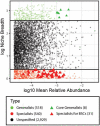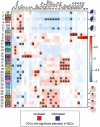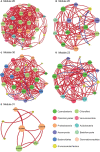A Comprehensive Network Integrating Signature Microbes and Crucial Soil Properties During Early Biological Soil Crust Formation on Tropical Reef Islands
- PMID: 35369528
- PMCID: PMC8969229
- DOI: 10.3389/fmicb.2022.831710
A Comprehensive Network Integrating Signature Microbes and Crucial Soil Properties During Early Biological Soil Crust Formation on Tropical Reef Islands
Abstract
Biological soil crusts (BSCs/biocrusts), which are distributed across various climatic zones and well-studied in terrestrial drylands, harbor polyextremotolerant microbial topsoil communities and provide ecological service for local and global ecosystem. Here, we evaluated BSCs in the tropical reef islands of the South China Sea. Specifically, we collected 41 BSCs, subsurface, and bare soil samples from the Xisha and Nansha Archipelagos. High-throughput amplicon sequencing was performed to analyze the bacterial, fungal, and archaeal compositions of these samples. Physicochemical measurement and enzyme activity assays were conducted to characterize the soil properties. Advanced computational analysis revealed 47 biocrust-specific microbes and 10 biocrust-specific soil properties, as well as their correlations in BSC microbial community. We highlighted the previously underestimated impact of manganese on fungal community regulation and BSC formation. We provide comprehensive insight into BSC formation networks on tropical reef islands and established a foundation for BSC-directed environmental restoration.
Keywords: biocrust formation; biological soil crust; enzyme activity; geographical distribution pattern; microbiome; tropical reef island.
Copyright © 2022 Wang, Li and Zhang.
Conflict of interest statement
The authors declare that the research was conducted in the absence of any commercial or financial relationships that could be construed as a potential conflict of interest.
Figures





Similar articles
-
Biocrust reduces the soil erodibility of coral calcareous sand by regulating microbial community and extracellular polymeric substances on tropical coral island, South China Sea.Front Microbiol. 2023 Dec 13;14:1283073. doi: 10.3389/fmicb.2023.1283073. eCollection 2023. Front Microbiol. 2023. PMID: 38152373 Free PMC article.
-
Biological soil crust elicits microbial community and extracellular polymeric substances restructuring to reduce the soil erosion on tropical island, South China Sea.Mar Environ Res. 2024 May;197:106449. doi: 10.1016/j.marenvres.2024.106449. Epub 2024 Mar 12. Mar Environ Res. 2024. PMID: 38492504
-
Optimizing the Production of Nursery-Based Biological Soil Crusts for Restoration of Arid Land Soils.Appl Environ Microbiol. 2019 Jul 18;85(15):e00735-19. doi: 10.1128/AEM.00735-19. Print 2019 Aug 1. Appl Environ Microbiol. 2019. PMID: 31152015 Free PMC article.
-
Insights into dryland biocrust microbiome: geography, soil depth and crust type affect biocrust microbial communities and networks in Mojave Desert, USA.FEMS Microbiol Ecol. 2020 Sep 1;96(9):fiaa125. doi: 10.1093/femsec/fiaa125. FEMS Microbiol Ecol. 2020. PMID: 32573682 Free PMC article.
-
Biological soil crusts and how they might colonize other worlds: insights from these Brazilian ecosystem engineers.J Exp Bot. 2022 Jul 16;73(13):4362-4379. doi: 10.1093/jxb/erac162. J Exp Bot. 2022. PMID: 35522077 Review.
Cited by
-
Characteristics of Carbonatogenic Bacteria and Their Role in Enhancing the Stability of Biocrusts in Tropical Coral Islands.Microorganisms. 2025 Feb 27;13(3):523. doi: 10.3390/microorganisms13030523. Microorganisms. 2025. PMID: 40142416 Free PMC article.
-
Biocrust reduces the soil erodibility of coral calcareous sand by regulating microbial community and extracellular polymeric substances on tropical coral island, South China Sea.Front Microbiol. 2023 Dec 13;14:1283073. doi: 10.3389/fmicb.2023.1283073. eCollection 2023. Front Microbiol. 2023. PMID: 38152373 Free PMC article.
-
Combined effects of biochar and biodegradable mulch film on chromium bioavailability and the agronomic characteristics of tobacco.Sci Rep. 2024 Mar 22;14(1):6867. doi: 10.1038/s41598-024-56973-8. Sci Rep. 2024. PMID: 38514728 Free PMC article.
-
The Community Structure of Aerobic Anoxygenic Photosynthetic Bacteria in Biocrusts on Tropical Coral Islands and Their Application in Ecological Restoration, South China Sea.Microorganisms. 2025 May 29;13(6):1265. doi: 10.3390/microorganisms13061265. Microorganisms. 2025. PMID: 40572153 Free PMC article.
References
-
- Aanderud Z. T., Smart T. B., Wu N., Taylor A. S., Zhang Y., Belnap J. (2018). Fungal loop transfer of nitrogen depends on biocrust constituents and nitrogen form. Biogeosciences 15 3831–3840. 10.5194/bg-15-3831-2018 - DOI
-
- Acosta-Martínez V., Cruz L., Sotomayor-Ramírez D., Pérez-Alegría L. (2007). Enzyme activities as affected by soil properties and land use in a tropical watershed. Appl. Soil Ecol. 35 35–45. 10.1016/j.apsoil.2006.05.012 - DOI
-
- Anderson M. J. (2001). A new method for non-parametric multivariate analysis of variance. Austral Ecol. 26 32–46. 10.1111/j.1442-9993.2001.01070.pp.x - DOI
LinkOut - more resources
Full Text Sources

